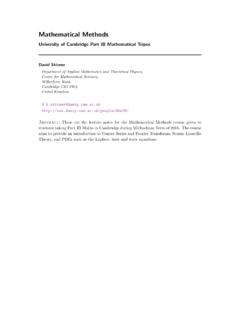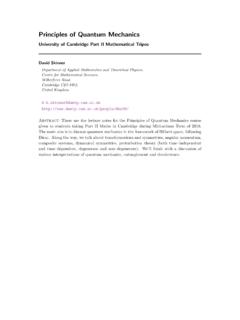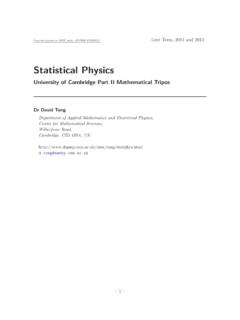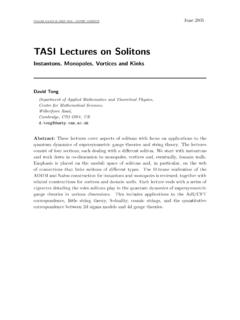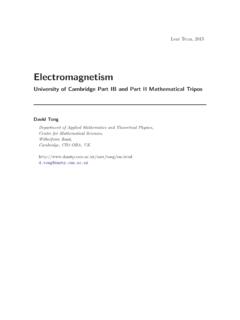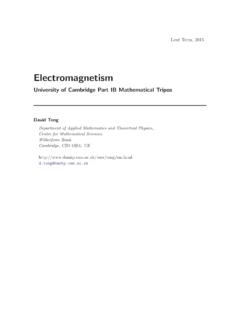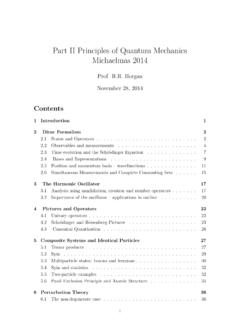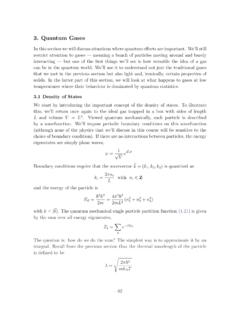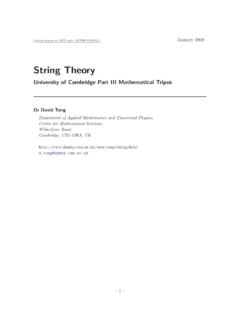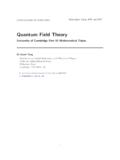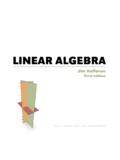Transcription of Part 3 General Relativity - University of Cambridge
1 Part 3 General Relativity Harvey Reall Part 3 General Relativity 4/11/13 ii Reall Contents Preface vii 1 Equivalence Principles 1. Incompatibility of Newtonian gravity and Special Relativity .. 1. The weak equivalence principle .. 2. The Einstein equivalence principle .. 4. Tidal forces .. 4. Bending of light .. 5. Gravitational red shift .. 6. Curved spacetime .. 8. 2 Manifolds and tensors 11. Introduction .. 11. Differentiable manifolds .. 12. Smooth functions .. 15. Curves and vectors .. 16. Covectors .. 20. Abstract index notation .. 22. Tensors .. 22. Tensor fields .. 27. The commutator .. 28. Integral curves .. 29. 3 The metric tensor 31. Metrics .. 31. Lorentzian signature .. 34. Curves of extremal proper time.
2 36. 4 Covariant derivative 39. Introduction .. 39. The Levi-Civita connection .. 43. iii CONTENTS. Geodesics .. 45. Normal coordinates .. 47. 5 Physical laws in curved spacetime 49. Minimal coupling, equivalence principle .. 49. Energy-momentum tensor .. 51. 6 Curvature 55. Parallel transport .. 55. The Riemann tensor .. 56. Parallel transport again .. 57. Symmetries of the Riemann tensor .. 59. Geodesic deviation .. 60. Curvature of the Levi-Civita connection .. 62. Einstein's equation .. 63. 7 Diffeomorphisms and Lie derivative 67. Maps between manifolds .. 67. Diffeomorphisms, Lie Derivative .. 69. 8 Linearized theory 77. The linearized Einstein equation .. 77. The Newtonian limit .. 80. Gravitational waves .. 83.
3 The field far from a source .. 88. The energy in gravitational waves .. 92. The quadrupole formula .. 95. 9 Differential forms 101. Introduction .. 101. Connection 1-forms .. 102. Spinors in curved spacetime .. 105. Curvature 2-forms .. 107. Volume form .. 108. Integration on manifolds .. 110. Submanifolds and Stokes' theorem .. 111. 10 Lagrangian formulation 115. Scalar field action .. 115. The Einstein-Hilbert action .. 116. Energy momentum tensor .. 119. Part 3 General Relativity 4/11/13 iv Reall CONTENTS. 11 The initial value problem 123. Introduction .. 123. Extrinsic curvature .. 123. The Gauss-Codacci equations .. 125. The constraint equations .. 128. Global hyperbolicity .. 128. 12 The Schwarzschild solution 131.
4 Introduction .. 131. Geodesics of the Schwarzschild solution .. 134. Null geodesics .. 135. Timelike geodesics .. 138. The Schwarzschild black hole .. 141. White holes and the Kruskal extension .. 145. 13 Cosmology 149. Spaces of constant curvature .. 149. De Sitter Spacetime .. 151. FLRW cosmology .. 158. Causal structure of FLRW universe .. 163. Part 3 General Relativity 4/11/13 v Reall CONTENTS. Part 3 General Relativity 4/11/13 vi Reall Preface These are lecture notes for the course on General Relativity in Part III of the Cambridge Mathematical Tripos. There are introductory GR courses in Part II. (Mathematics or Natural Sciences) so, although self-contained, this course does not cover topics usually covered in a first course, , the Schwarzschild solution, the solar system tests, and cosmological solutions.
5 For completeness, this material can be found in Chapters 12 and 13 which were not covered in lectures. Some more advanced topics ( Penrose diagrams) are also discussed in these chapters. You are encouraged to read chapter 12 if you are not attending the Black Holes course and to read chapter 13 if you are not attending the Cosmology course. Acknowledgment I am very grateful to Andrius S tikonas for producing the figures. vii chapter 0. PREFACE. Part 3 General Relativity 4/11/13 viii Reall chapter 1. Equivalence Principles Incompatibility of Newtonian gravity and Spe- cial Relativity Special Relativity has a preferred class of observers: inertial (non-accelerating). observers. Associated to any such observer is a set of coordinates (t, x, y, z) called an inertial frame.
6 Different inertial frames are related by Lorentz transformations. The Principle of Relativity states that physical laws should take the same form in any inertial frame. Newton's law of gravitation is 2 = 4 G ( ). where is the gravitational potential and the mass density. Lorentz transforma- tions mix up time and space coordinates. Hence if we transform to another inertial frame then the resulting equation would involve time derivatives. Therefore the above equation does not take the same form in every inertial frame. Newtonian gravity is incompatible with special Relativity . Another way of seeing this is to look at the solution of ( ): Z. (t, y). (t, x) = G d3 y ( ). |x y|. From this we see that the value of at point x will respond instantaneously to a change in at point y.
7 This violates the Relativity principle: events which are simultaneous (and spatially separated) in one inertial frame won't be simultaneous in all other inertial frames. The incompatibility of Newtonian gravity with the Relativity principle is not a problem provided all objects are moving non-relativistically ( with speeds 1. chapter 1. EQUIVALENCE PRINCIPLES. much less than the speed of light c). Under such circumstances, in the Solar System, Newtonian theory is very accurate. Newtonian theory also breaks down when the gravitational field becomes strong. Consider a particle moving in a circular orbit of radius r about a spherical body of mass M , so = GM/r. Newton's second law gives v 2 /r = GM/r2 hence v 2 /c2 = | |/c2.
8 Newtonian theory requires non-relativistic motion, which is the case only if the gravitational field is weak: | |/c2 1. In the Solar System | |/c2 < 10 5 . r m M. Figure : Circular orbit GR is the theory that replaces both Newtonian gravity and special Relativity . The weak equivalence principle The equivalence principle was an important step in the development of GR. There are several forms of the EP, which are motivated by thought experiments involving Newtonian gravity. (If we consider only experiments in which all objects move non- relativistically then the incompatibility of Newtonian gravity with the Relativity principle is not a problem.). In Newtonian theory, one can distinguish between the notions of inertial mass mI , which appears in Newton's second law: F = mI a, and gravitational mass, which governs how a body interacts with a gravitational field: F = mG g.
9 Note that this equation defines both mG and g hence there is a scaling ambiguity g g and mG 1 mG (for all bodies). We fix this by defining mI /mG = 1 for a particular test mass, , one made of platinum. Experimentally it is found that other bodies made of other materials have mI /mG 1 = O(10 12 ) (Eo tvo s experiment). The exact equality of mI and mG for all bodies is one form of the weak equiv- alence principle. Newtonian theory provides no explanation of this equality. The Newtonian equation of motion of a body in a gravitational field g(x, t) is mI x = mG g(x(t), t) ( ). Part 3 General Relativity 4/11/13 2 Reall THE WEAK EQUIVALENCE PRINCIPLE. using the weak EP, this reduces to x = g(x(t), t) ( ). Solutions of this equation are uniquely determined by the initial position and velocity of the particle.
10 Any two particles with the same initial position and velocity will follow the same trajectory. This means that the weak EP can be restated as: The trajectory of a freely falling test body depends only on its initial position and velocity, and is independent of its composition. By test body we mean an uncharged object whose gravitational self-interaction is negligible, and whose size is much less than the length over which external fields such as g vary. Consider a new frame of reference moving with constant acceleration a with respect to the first frame. The origin of the new frame has position X(t) where X = a. The coordinates of the new frame are t0 = t and x0 = x X(t). Hence the equation of motion in this frame is x 0 = g a g0 ( ).
